We'll use the same halters and leads when we start horses under saddle. When the animals are ready for some refinement, we'll purchase a good quality snaffle bit and use a well made mecate rein with slobber straps. Again, this equipment gives the horse a better sense of the rider's cues which is so important when training (or retraining) a saddle horse.
Use Equipment Correctly.
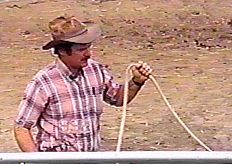 Time and again we sit down to watch a trainer in the area work a horse. It often doesn't take long to figure out which of these trainers made it based on knowledge, preparation and skill and which ones got by on pure luck. Watching some of these trainers, we'd honestly prefer to hand one of our green horses over to a beginner who would follow some basic safety precautions than a few kamikazis that we've seen. So here are a few important tips that will keep you safe and should help prevent people from using you as the next example of what not to do.
Time and again we sit down to watch a trainer in the area work a horse. It often doesn't take long to figure out which of these trainers made it based on knowledge, preparation and skill and which ones got by on pure luck. Watching some of these trainers, we'd honestly prefer to hand one of our green horses over to a beginner who would follow some basic safety precautions than a few kamikazis that we've seen. So here are a few important tips that will keep you safe and should help prevent people from using you as the next example of what not to do.
A lead rope is not a lariat. It sounds simple enough but lots of folks don't get it. A lariat is waxed and stiff and is designed to be held in coils. A lead or horse handling rope is usually made of a soft poly material. It can change shape extremely quickly. If a soft rope is held in coils and the horse bolts, the coils can instantly slip tight around the handler's hand, creating a several potential problems ranging from pulling the handler off balance to costing the handler his or her hand.
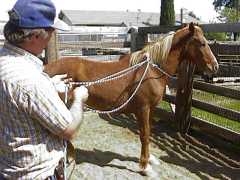 In 1992 as a trauma surgeon was discussing rope injuries at the "Equestrian Crash Course" trauma workshop, his pager sounded. He had to leave to try to save the hand of an equestrian who had a loop close around his hand when a horse he was handling broke away.
In 1992 as a trauma surgeon was discussing rope injuries at the "Equestrian Crash Course" trauma workshop, his pager sounded. He had to leave to try to save the hand of an equestrian who had a loop close around his hand when a horse he was handling broke away.
Carry your lead rope in folds. Don't let long ropes tangle around your body or legs. Never hold onto a horse with something you can't easily let go of and step away from. Even though we teach our horses to remain calm and tolerate unexpected things, we never know when something beyond our control could possibly trigger a flight response in a horse.
 A "flag" is not a weapon. Twenty years ago most "natural" horse trainers used flags (plastic grocery bags tied onto the ends of sticks.) Flags made it easy to generate energy and put it, or direct it, in locations distant from the handler's hands. Flags also generated both visible and auditory stimulus. Most horse would wake up, pay attention, and move away from flag pressure. A flag was a great tool.
A "flag" is not a weapon. Twenty years ago most "natural" horse trainers used flags (plastic grocery bags tied onto the ends of sticks.) Flags made it easy to generate energy and put it, or direct it, in locations distant from the handler's hands. Flags also generated both visible and auditory stimulus. Most horse would wake up, pay attention, and move away from flag pressure. A flag was a great tool.
But occasionally we would come across a horse whose mind had been totally blown by misuse of flags. The most recent would simply bolt and jump the nearest fence if he saw a white grocery bag flag, but he would work fine if we tied a plastic red "long load" flag that we got from Lowe's on the stick. The more traditional training flag generated instant and unequivocal panic.
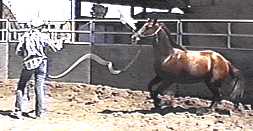 In cases where we were able to trace the history of a horse's "flag paranoia," it typically led to the constant harassment of the horse by a trainer or handler with the flag and an attitude that "If I keep it up the horse will have to submit and accept the flag." Of course, then it's the horse's fault when he becomes steadily more "right brained" and unstable to the point of being dangerous.
In cases where we were able to trace the history of a horse's "flag paranoia," it typically led to the constant harassment of the horse by a trainer or handler with the flag and an attitude that "If I keep it up the horse will have to submit and accept the flag." Of course, then it's the horse's fault when he becomes steadily more "right brained" and unstable to the point of being dangerous.
A flag can be a very effective tool with which to direct energy and to also reinforce other cues, however the handler has to observe the horse, reward the slightest try and not drive the horse into "right brain" mode.
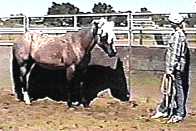 We've noticed that some training programs have switched from flags to a light weight ropes on sticks. While these aids could also be misused, it may be that people tend to focus more on what happens with the rope when they handle the stick and stay more connected to the effect of their actions. The important concept is that none of these aids are intended to be weapons. They are communications devices, and if all we do is continually "shout" at horses with these devices the animals are more likely to become reactive, sullen and unstable rather than respond intelligently and willingly to our cues.
We've noticed that some training programs have switched from flags to a light weight ropes on sticks. While these aids could also be misused, it may be that people tend to focus more on what happens with the rope when they handle the stick and stay more connected to the effect of their actions. The important concept is that none of these aids are intended to be weapons. They are communications devices, and if all we do is continually "shout" at horses with these devices the animals are more likely to become reactive, sullen and unstable rather than respond intelligently and willingly to our cues.
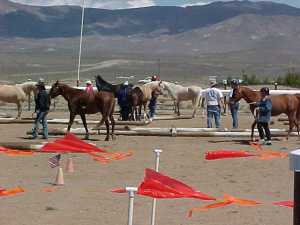

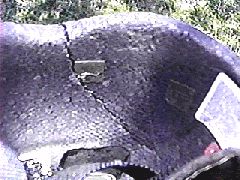 For years we trained and rode wearing leather cowboy hats or baseball caps. When several riders in the region suffered critical or fatal head and limb injuries while riding, a couple of our training barns, the fire department, ambulance provider, trauma center and medical helicopter service organized a serious seminar that addressed horse related accidents.
For years we trained and rode wearing leather cowboy hats or baseball caps. When several riders in the region suffered critical or fatal head and limb injuries while riding, a couple of our training barns, the fire department, ambulance provider, trauma center and medical helicopter service organized a serious seminar that addressed horse related accidents.
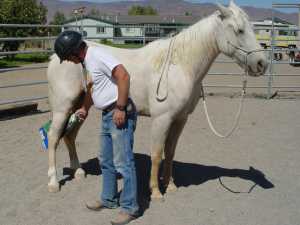 Today's equestrian helmets are light weight, airy and relatively inexpensive and the ones we bought really paid off. Similarly people without helmets have done something as simple as trip to end up splitting their scalps on sharp rocks, or have temporarily lost their wits when knocked against something hard at a very inopportune time. Our neighbor tried to see if she could stuff her head through a utility pole while on a runaway Arabian. She's now riding Arabians in the afterlife. Some other folks have ended up with facial or skull fractures. Virtually all of these serious or fatal injuries were avoidable.
Today's equestrian helmets are light weight, airy and relatively inexpensive and the ones we bought really paid off. Similarly people without helmets have done something as simple as trip to end up splitting their scalps on sharp rocks, or have temporarily lost their wits when knocked against something hard at a very inopportune time. Our neighbor tried to see if she could stuff her head through a utility pole while on a runaway Arabian. She's now riding Arabians in the afterlife. Some other folks have ended up with facial or skull fractures. Virtually all of these serious or fatal injuries were avoidable.

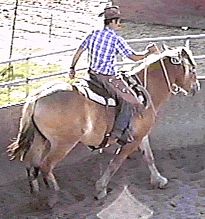 Every product has a cheap counterpart. In the long run the cheapest halter and lead is probably the most expensive. We still have two original rope halters that Pat Parelli and Oscar Thompson tied for us back in the 1980s. They've been on literally hundreds of horses including one
Every product has a cheap counterpart. In the long run the cheapest halter and lead is probably the most expensive. We still have two original rope halters that Pat Parelli and Oscar Thompson tied for us back in the 1980s. They've been on literally hundreds of horses including one  Time and again we sit down to watch a trainer in the area work a horse. It often doesn't take long to figure out which of these trainers made it based on knowledge, preparation and skill and which ones got by on pure luck. Watching some of these trainers, we'd honestly prefer to hand one of our green horses over to a beginner who would follow some basic safety precautions than a few kamikazis that we've seen. So here are a few important tips that will keep you safe and should help prevent people from using you as the next example of what not to do.
Time and again we sit down to watch a trainer in the area work a horse. It often doesn't take long to figure out which of these trainers made it based on knowledge, preparation and skill and which ones got by on pure luck. Watching some of these trainers, we'd honestly prefer to hand one of our green horses over to a beginner who would follow some basic safety precautions than a few kamikazis that we've seen. So here are a few important tips that will keep you safe and should help prevent people from using you as the next example of what not to do.
 In 1992 as a trauma surgeon was discussing rope injuries at the "Equestrian Crash Course" trauma workshop, his pager sounded. He had to leave to try to save the hand of an equestrian who had a loop close around his hand when a horse he was handling broke away.
In 1992 as a trauma surgeon was discussing rope injuries at the "Equestrian Crash Course" trauma workshop, his pager sounded. He had to leave to try to save the hand of an equestrian who had a loop close around his hand when a horse he was handling broke away.
 A "flag" is not a weapon. Twenty years ago most "natural" horse trainers used flags (plastic grocery bags tied onto the ends of sticks.) Flags made it easy to generate energy and put it, or direct it, in locations distant from the handler's hands. Flags also generated both visible and auditory stimulus. Most horse would wake up, pay attention, and move away from flag pressure. A flag was a great tool.
A "flag" is not a weapon. Twenty years ago most "natural" horse trainers used flags (plastic grocery bags tied onto the ends of sticks.) Flags made it easy to generate energy and put it, or direct it, in locations distant from the handler's hands. Flags also generated both visible and auditory stimulus. Most horse would wake up, pay attention, and move away from flag pressure. A flag was a great tool.
 In cases where we were able to trace the history of a horse's "flag paranoia," it typically led to the constant harassment of the horse by a trainer or handler with the flag and an attitude that "If I keep it up the horse will have to submit and accept the flag." Of course, then it's the horse's fault when he becomes steadily more "right brained" and unstable to the point of being dangerous.
In cases where we were able to trace the history of a horse's "flag paranoia," it typically led to the constant harassment of the horse by a trainer or handler with the flag and an attitude that "If I keep it up the horse will have to submit and accept the flag." Of course, then it's the horse's fault when he becomes steadily more "right brained" and unstable to the point of being dangerous.
 We've noticed that some training programs have switched from flags to a light weight ropes on sticks. While these aids could also be misused, it may be that people tend to focus more on what happens with the rope when they handle the stick and stay more connected to the effect of their actions. The important concept is that none of these aids are intended to be weapons. They are communications devices, and if all we do is continually "shout" at horses with these devices the animals are more likely to become reactive, sullen and unstable rather than respond intelligently and willingly to our cues.
We've noticed that some training programs have switched from flags to a light weight ropes on sticks. While these aids could also be misused, it may be that people tend to focus more on what happens with the rope when they handle the stick and stay more connected to the effect of their actions. The important concept is that none of these aids are intended to be weapons. They are communications devices, and if all we do is continually "shout" at horses with these devices the animals are more likely to become reactive, sullen and unstable rather than respond intelligently and willingly to our cues.